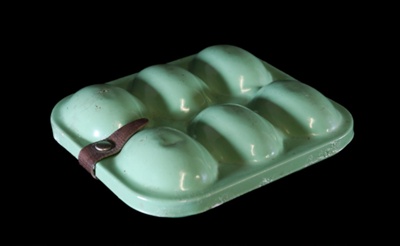Name/TitleEgg Container
About this objectA tin egg container painted green, shaped to hold six eggs and with space to hold cotton wool and tissue paper inside to protect the eggs. It has a leather strap bearing a press stud to close the container. It is stamped ‘PAT.APPLIED FOR’. This egg container was used by the grandmother of the donor who was born at the end of the 19th century. It was most likely used by her from the first quarter of the 20th century onwards.
Richard Hall, Research Volunteer:
The container has been painted green, although that may not have been its original colour; nor is it clear whether the container was actually intended for another purpose, before being carefully re-purposed into an egg carrier. This theory may be disproved, since the box also contains markings to suggest that a patent had been applied for, presumably either for the design or its fastening. However, a search of UK and American patents, failed to confirm that a patent was ever granted.
Although having protective shells, it is a well-known fact that eggs break quite easily! Ever since chickens were domesticated to produce eggs and meat, various methods have been needed to ensure eggs arrived at the kitchen door in one piece. Traditionally eggs might have been carried in a wicker basket, lined with straw to prevent the eggs from rolling around in transit. Needless to say, a basket wasn’t always the best solution, which probably gave rise to the adage: “Don’t put all of your eggs in the same basket.” Suggesting perhaps that, it’s better to have a back-up in case something goes wrong.
Whilst generally acceptable for small domestic supply, larger consumers, such as professional bakers, needed their eggs to be supplied in bulk. Packing eggs in wooden or even metal boxes, lined with straw and paper was the solution, albeit that the product often arrived broken in transit.
In 1911, a Canadian newspaper editor, Joseph Coyle , was the first to conceive and produce a carton which could transport eggs safely. The design was improved on in 1931 when Francis Sherman , patented a paper pulp version of the carrier, which was cheap to produce and is still in use today.
Medium and MaterialsPainted tin, leather, stud.
Inscription and MarksIt is stamped "PAT. APPLIED FOR".
MeasurementsLength: 175 mm
Width: 145 mm
Height: 45 mm
Object numberSTMEA:A.7213
Copyright Licence![]() Attribution - Non-commercial (cc)
Attribution - Non-commercial (cc)



